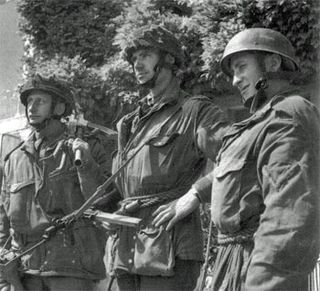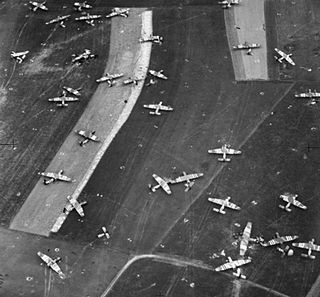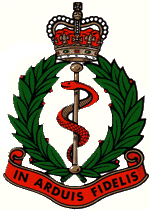(Thomas Wood) Ingram Cleasby was the Dean of Chester in the latter part of the 20th century. [1]
(Thomas Wood) Ingram Cleasby was the Dean of Chester in the latter part of the 20th century. [1]
Ingram Cleasby was born on 27 March 1920 in Kendal, Westmorland, England, and was educated at Sedbergh and Magdalen College, Oxford. [2]
He saw active service with the British Army during the Second World War, receiving a commission as a second lieutenant into the Border Regiment on 14 December 1940, his service number being 160854. [3] [4] Cleasby was posted to the regiment's 1st Battalion, a Regular Army unit. [4] The battalion was one of four which formed part of the 31st Independent Brigade, and in late 1941 was transferred to the airborne forces, with the brigade being redesignated the 1st Airlanding Brigade, which now formed part of Major General Frederick Browning's 1st Airborne Division. After training throughout 1942 most of the division, now under Major General George Hopkinson, departed for North Africa in April 1943, and Cleasby's 1st Airlanding Brigade, under Brigadier Philip Hicks, took part in the Allied invasion of Sicily (see Operation Ladbroke). The brigade, including Cleasby's battalion, suffered heavily before being withdrawn to North Africa. In September it landed in Italy and fought briefly in the early stages of the Italian Campaign until again being withdrawn, this time to the United Kingdom, arriving there in mid-December. Not involved in the Normandy landings, the division, now under Major General Roy Urquhart, participated in September 1944 in Operation Market Garden. [4] By this time Cleasby was Officer Commanding (OC) the Support Company's Machine Gun Group, and during the Battle of Arnhem he was wounded in action and captured, spending the rest of the war as a prisoner of war (POW) until his release in April 1945, shortly before the end of World War II in Europe the following month. [4]
He was ordained in 1954. Initially a Curate at Huddersfield Parish Church [5] he became Chaplain to the Archbishop of York in 1952. Following this he was Anglican Chaplain to the University of Nottingham and then Archdeacon of Chesterfield (1963–1978) [6] before his elevation to the Deanery. [7] Described in his Daily Telegraph obituary as a "broad, inclusive, traditional Anglican", he died in Dent, Cumbria, at the age of 88 on 9 February 2009. [8]

Operation Ladbroke was a glider landing by British airborne troops during the Second World War near Syracuse, Sicily, that began on 9 July 1943 as part of Operation Husky, the Allied invasion of Sicily. The first Allied mission using large numbers of the aircraft, the operation was carried out from Tunisia by glider infantry of the British 1st Airlanding Brigade, commanded by Brigadier Philip Hicks, with a force of 136 Waco Hadrians and eight Airspeed Horsas. The objective was to establish a large invasion force on the ground near the town of Syracuse, secure the Ponte Grande Bridge and ultimately take control of the city itself with its strategically vital docks, as a prelude to the full-scale invasion of Sicily.

The 1st Airborne Division was an airborne infantry division of the British Army during the Second World War. The division was formed in late 1941 during the Second World War, after the British Prime Minister, Winston Churchill, demanded an airborne force, and was initially under command of Major-General Frederick A. M. Browning. The division was one of two airborne divisions raised by the British Army during the war, with the other being the 6th Airborne Division, created in May 1943, using former units of the 1st Airborne Division.

The 6th Airborne Division was an airborne infantry division of the British Army during the Second World War. Despite its name, the 6th was actually the second of two airborne divisions raised by the British Army during the war, the other being the 1st Airborne Division. The 6th Airborne Division was formed in the Second World War, in mid-1943, and was commanded by Major-General Richard N. Gale. The division consisted of the 3rd and 5th Parachute Brigades along with the 6th Airlanding Brigade and supporting units.

General Sir Richard Nelson "Windy" Gale, was a senior officer in the British Army who served in both world wars. In the First World War he was awarded the Military Cross in 1918 whilst serving as a junior officer in the Machine Gun Corps. During the Second World War he served with 1st Parachute Brigade and then the 6th Airborne Division during the D-Day landings and Operation Tonga in 1944. After the end of the conflict, Gale remained in the army and eventually, in 1958, succeeded Field Marshal The Viscount Montgomery as Deputy Supreme Allied Commander Europe.

The 5th Parachute Brigade was an airborne forces formation of brigade strength, raised by the British Army during the Second World War. Created during 1943, the brigade was assigned to the 6th Airborne Division, serving alongside the 3rd Parachute Brigade and the 6th Airlanding Brigade.

The 2nd Parachute Brigade was an airborne forces brigade formed by the British Army during the Second World War.

The 4th Parachute Brigade was an airborne, specifically a parachute infantry, brigade formation of the British Army during the Second World War. Formed in late 1942 in the Mediterranean and Middle East, the brigade was composed of three parachute infantry units, the 10th, 11th and 156th Parachute Battalions.

The 1st Airlanding Brigade was an airborne infantry brigade of the British Army during the Second World War and the only glider infantry formation assigned to the 1st Airborne Division, serving alongside the 1st Parachute Brigade and 4th Parachute Brigade.

The 44th Indian Airborne Division was an airborne forces division of the Indian Army during World War II, created in 1944. It provided a parachute battalion for one minor airborne operation, but the war ended before the complete formation could take part..

The 6th Airlanding Brigade was an airborne infantry brigade of the British Army during the Second World War. Created during May 1943, the brigade was composed of three glider infantry battalions and supporting units, and was assigned to the 6th Airborne Division, alongside the 3rd and 5th Parachute Brigades.
Major General George Frederick Hopkinson OBE MC was a senior British Army officer who commanded the 1st Airborne Division during World War II, where he was killed in action in Italy. He was the only British Airborne general to be killed during the conflict.

Operation Mallard was the codename for an airborne forces operation, which was conducted by the British Army on 6 June 1944, as part of the Normandy landings during the Second World War.

Lieutenant Colonel Richard "Dickie" Thomas Henry Lonsdale, was an officer of the British Army who served with the Parachute Regiment throughout much of the Second World War.

Brigadier Philip Hugh Whitby Hicks was an officer of the British Army during both the First and Second World Wars.

The 181st (Airlanding) Field Ambulance was a Royal Army Medical Corps unit of the British airborne forces during the Second World War.

The 195th (Airlanding) Field Ambulance was a Royal Army Medical Corps unit of the British airborne forces during the Second World War.

The Battle of Bréville was fought by the British 6th Airborne Division and the German 346th Infantry Division, between 8 and 13 June 1944, during the early phases of the invasion of Normandy in the Second World War.

The 1st Airlanding Light Regiment was an airborne forces unit of the British Army's Royal Artillery during the Second World War.
William Francis Kynaston "Sheriff" Thompson OBE was a British soldier and journalist. Born in Greenwich, London in 1909 Thompson served in the army for 30 years before becoming the defence correspondent of the Daily Telegraph.